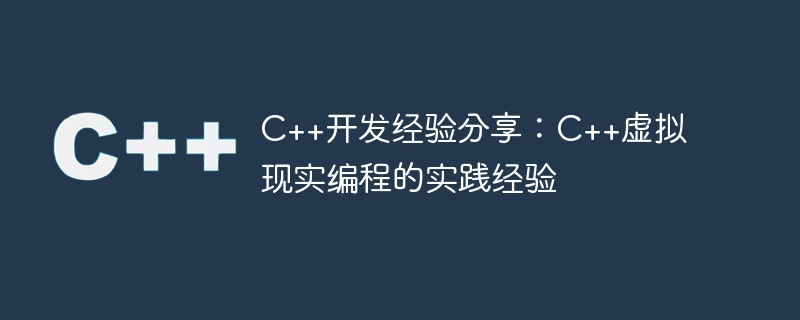Home >Backend Development >C++ >C++ development experience sharing: Practical experience in C++ virtual reality programming
C++ development experience sharing: Practical experience in C++ virtual reality programming
- WBOYWBOYWBOYWBOYWBOYWBOYWBOYWBOYWBOYWBOYWBOYWBOYWBOriginal
- 2023-11-22 08:29:381061browse

C Development experience sharing: C Practical experience in virtual reality programming
With the continuous advancement of technology, virtual reality technology is increasingly becoming one of the hot spots in today’s technology field . Virtual reality technology provides users with a new immersive experience by simulating the real environment. In virtual reality technology, C is a widely adopted programming language that is efficient, flexible, and portable. This article will introduce some tips and precautions in C virtual reality programming by sharing personal practical experience.
First of all, to achieve good results in C virtual reality programming, an important factor is good programming specifications and structures. Although the C language itself is flexible, in the virtual reality development process, a good code structure can improve the readability and maintainability of the code. In order to achieve this, the modular design idea can be used to divide the code into multiple modules, each module is responsible for the implementation of specific functions. At the same time, be careful to avoid excessive use of global variables to avoid excessive coupling of the code.
Secondly, for virtual reality technology, performance is a very important issue. Virtual reality applications need to maintain a continuously high frame rate to provide a smooth user experience. Therefore, when writing a C virtual reality program, you need to pay attention to the performance optimization of the code. You can minimize memory usage and avoid frequent memory allocation and release operations. In addition, some optimization techniques can also be used, such as using GPU acceleration to avoid unnecessary calculations and data copies.
In addition, virtual reality applications involve more hardware devices than traditional computer applications. In C virtual reality programming, you need to interact with sensors, displays, audio devices, etc. In order to achieve seamless connection with hardware devices, you can use some open source libraries and APIs in C, such as OpenVR, ARToolKit, etc. These libraries and APIs provide rich interfaces and functions that can greatly simplify the interaction process with hardware devices.
In addition, you also need to pay attention to handling input and output in C virtual reality programming. For input, VR applications usually need to obtain some information from the user, such as head pose, gestures, etc. For output, VR applications usually need to display some information to the user, such as graphics rendering, sound output, etc. When processing input and output, you can use the input and output libraries provided by C, such as iostream, fstream, etc. In addition, you can also use some graphics and audio libraries, such as OpenGL, OpenAL, etc., to achieve graphics rendering and sound output.
Finally, in C virtual reality programming, debugging and testing are very critical links. During the development process, you may encounter various errors and bugs, so you need to use some professional debugging and testing tools to locate and fix problems. In terms of debugging, you can use a debugger to track the execution process of the code and debug the program step by step. In terms of testing, you can use some automated testing tools, such as Google Test, Unity Test, etc., to perform unit testing and integration testing to ensure the normal operation of the program.
To sum up, C virtual reality programming is a very challenging and interesting field. Through practical experience in good programming specifications and structures, performance optimization, interaction with hardware devices, input and output processing, debugging and testing, etc., developers can be helped to better deal with various problems in C virtual reality programming. I hope this article can provide some reference and inspiration for beginners of C virtual reality programming to better start their own virtual reality development journey.
The above is the detailed content of C++ development experience sharing: Practical experience in C++ virtual reality programming. For more information, please follow other related articles on the PHP Chinese website!
Related articles
See more- Swoole's common practical experience in developing high-availability data synchronization services
- MySQL double write buffer mechanism: performance optimization strategies and practical experience sharing
- Guide and practical experience on how to build scalable data processing and storage systems using Vue.js and Groovy language
- Summary of practical experience in Git and team collaboration
- Practical experience in Java development: using MQTT to implement IoT functions

